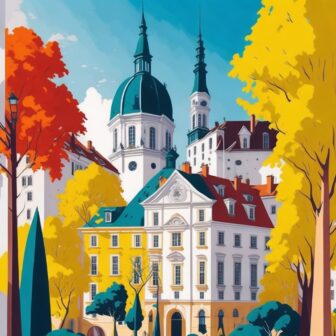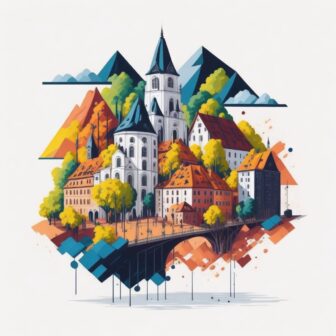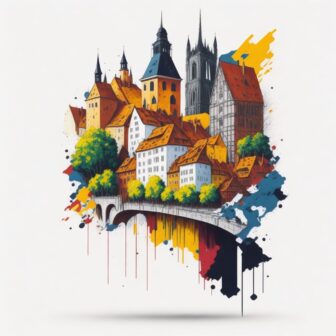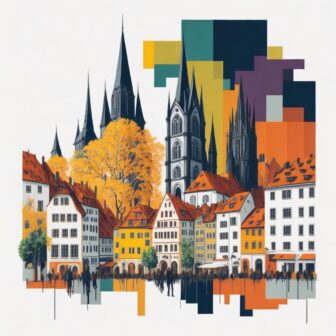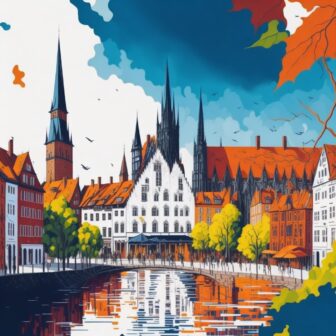12 Best Places to Visit in Lueneburg in 2023
Welcome to Lüneburg, a captivating city boasting an array of remarkable landmarks and attractions that will leave you spellbound. From its enchanting historic sites to breathtaking vistas, Lüneburg offers an unforgettable journey into its rich heritage and scenic beauty.
Join me as I embark on an exploration of the best places to visit, iconic landmarks, and enticing attractions that make Lüneburg a must-see destination for every avid traveler.
In a nutshell: Lüneburg Highlights
- Lüneburg is one of the most beautiful cities in Germany and has captivated us instantly.
- The Stintmarkt with the old crane is undoubtedly the most popular photo motif in Lüneburg.
- Enjoy the stunning cityscape from the water tower on the edge of the old town.
- Immerse yourself in the unique experience of the German Salt Museum, located in a former salt works.
1. Stintmarkt and Old Crane
Am Stint, situated in the charming water district of Lüneburg, beckons visitors with its delightful Stintmarkt and captivating old crane. This picturesque area, infused with historical charm, is widely regarded as the quintessential photo motif of Lüneburg.
The Stintmarkt, aptly named after the smelt fish that once flourished in these waters and were traded here, now offers a serene ambiance where visitors can indulge in delectable culinary delights, refreshing drinks, and marvel at the surrounding beauty.
While the bustling smelt market of the past has ceased to exist, its spirit lives on as locals and tourists alike gather to savor the gastronomic offerings, appreciate the scenic views, and bask in the lively atmosphere, particularly during the vibrant summer months.
2. Am Sande
Am Sande, the largest square nestled within Lüneburg’s historic old town, owes its name to its sandy origins. In bygone eras, this bustling square was covered in sand, giving it a distinct character that endures to this day.
Today, Am Sande serves as Lüneburg’s bustling central transport hub, where a network of buses connects the city to its surrounding districts and suburbs. As travelers embark on their journeys, the square remains abuzz with activity, providing a vibrant and dynamic backdrop to the daily rhythm of the city.
Radiating from Am Sande, a tapestry of architectural marvels adorns the cityscape, showcasing Lüneburg’s rich history and cultural heritage. The surrounding buildings, with their captivating facades and impressive gables, stand as testaments to the city’s prosperous past. Gazing upward, one cannot help but be captivated by the intricate details and timeless elegance of these well-preserved structures.
At the far end of the square, a true gem awaits discovery. The remarkable building, crafted from black and white glazed bricks, stands tall and proud. Initially serving as a brewery in 1548, this architectural masterpiece now houses the IHK (Chamber of Commerce and Industry), further adding to the allure and significance of Am Sande.
3. Lüneburg Subsidence Area
Embarking on a leisurely stroll along Grapengiesserstrasse from Am Sande, visitors will notice a gradual descent, as if the road itself is gently embracing the natural contours of the land.
This marks the beginning of the illustrious Lüneburg subsidence area, one of the most captivating and cherished parts of the city center. Immersed in a maze of narrow, winding streets, this district invites exploration and promises delightful surprises at every turn.
The subsidence area derives its name from the intriguing geological phenomenon that has shaped Lüneburg’s landscape for centuries. As a result of extensive salt mining activities that spanned generations, the ground beneath the city gradually subsided.
The mighty salt dome, nestled beneath the surface, played a pivotal role in both the city’s prosperity and the subsequent shifts in the terrain. Today, remnants of this geological history manifest in the unique and captivating architecture that defines the subsidence area.
Amidst this enchanting district, a walk through the meandering streets offers glimpses into Lüneburg’s past. Lovingly restored old houses stand as witnesses to the city’s resilience and enduring spirit. Each building tells a story, preserving fragments of a bygone era within its weathered walls and crooked beams. It’s a testament to the indomitable human spirit, which refuses to be defined by the subtle leanings and imperfections that time has bestowed upon these architectural treasures.
4. Old Town Hall and Market Square
Market Square, adorned with its iconic old town hall and a vibrant ambiance, serves as the pulsating heart of Lüneburg’s old town. Stepping onto this historical square, visitors are instantly captivated by the charming fusion of architectural splendor and lively market activities.
On Wednesdays and Saturdays, the square transforms into a bustling hub of trade and commerce as vendors set up their stalls for the weekly market—a vibrant tapestry of sights, sounds, and flavors that delights the senses.
The old town hall, with its resplendent baroque façade, stands as one of Lüneburg’s most magnificent buildings. Its grandeur is matched by the captivating interior, which can be explored through informative guided tours, providing an intimate glimpse into the city’s governance and historical significance.
These guided tours, offered daily except on Mondays, provide an enriching experience for visitors keen to delve deeper into Lüneburg’s past. To embark on this journey of discovery, a nominal entry fee of 5 euros is required. For current tour schedules and convenient online booking, the Lüneburg Tourismus website serves as an invaluable resource.
5. View from the Water Tower
Perched on the edge of Lüneburg’s old town, the majestic water tower offers an unparalleled vantage point to behold the city’s mesmerizing panorama. Whether ascending via the elevator or opting for a leisurely climb up the 56-meter high tower, visitors are rewarded with breathtaking views that span the entire expanse of Lüneburg.
Within the tower’s hallowed walls, a small exhibition awaits curious minds, offering fascinating insights into the vital role of water in shaping the city’s history and development.
Open daily from 10:00 a.m. to 6:00 p.m., the water tower invites visitors to immerse themselves in the captivating tales of Lüneburg’s aquatic legacy. A modest admission fee of 5.00 euros grants access to this treasure trove of knowledge and wonder.
6. German Salt Museum in Lüneburg
Lüneburg owes not only its subsidence but also its wealth to the centuries-old tradition of salt mining. For many years, salt was the lifeblood of the city, driving its prosperity and shaping its identity.
In 1980, the era of salt mining in Lüneburg came to an end. However, a small exception remains—the Lüneburger Therme continues to extract salt as a testament to this rich heritage.
Preserving the legacy of salt mining and honoring Lüneburg’s “white gold,” the German Salt Museum finds its abode within the confines of the former saltworks.
Here, visitors are immersed in an educational journey that unravels the secrets of salt mining and showcases its profound impact on the city’s history, economy, and culture. Embarking on this enlightening expedition, visitors gain a newfound appreciation for the significance of salt in shaping Lüneburg’s destiny.
To explore the multifaceted world of the German Salt Museum further, the museum’s dedicated website provides invaluable information and serves as a gateway to an enriching cultural experience.
RELATED:
Famous Landmarks in Germany You Must Visit
8. Old Council Pharmacy
While venturing through Lüneburg’s old town, surrender yourself to the whims of curiosity and let the labyrinthine streets guide your exploration. Despite its relatively compact size, the town promises delightful encounters with remarkable buildings and hidden gems waiting to bediscovered.
Since 1524, the old council pharmacy has graced Große Bäckerstraße 9 with its presence. Beyond its vibrant exterior, the pharmacy boasts a treasury of history.
Step inside to marvel at the colorful portal, which serves as a captivating prelude to the meticulously preserved interiors. Amidst the wooden shelves, antique glassware, and apothecary jars, the old council pharmacy weaves a tale of healing and knowledge, inviting visitors to embark on a journey through time.
9. St. John’s Church
Nestled within the bustling embrace of Am Sande, St. John’s Church stands as a testament to Lüneburg’s spiritual heritage. As the oldest and largest church in the city, it stands tall, exuding a sense of quiet grandeur.
The imposing church tower, though slightly askew due to an architect’s misstep, serves as a reminder of the fallibility of human endeavors. Legend tells the tale of a master builder who, upon realizing his mistake, fell from the tower only to land safely on a passing hay wagon—an improbable twist of fate that adds to the mystique surrounding this sacred landmark.
10. St. Michaelis and St. Nicolai
For those with a penchant for exploring architectural marvels, Lüneburg presents two more impressive churches—St. Michaelis and St. Nicolai. Like their counterpart, St. John’s Church, these houses of worship stand as prime examples of the region’s brick Gothic style.
As visitors step inside, they are enveloped in an aura of tranquility, basking in the ethereal beauty of stained glass windows, ornate altars, and soaring vaulted ceilings.
11. The Pregnant House
A peculiar sight awaits curious gazes near the town hall—a house with a distinctive dent in its façade. The sagging caused by moisture absorption in the masonry lends the building a unique character, a visual reminder of the passage of time and the imperfections that lend charm to the urban landscape.
12. Filming Location for “Red Roses”
When the mention of Lüneburg arises, it is not uncommon for friends and relatives to evoke the popular television series, “Red Roses.” Since its inception in 2006, this beloved afternoon drama has captivated audiences with its captivating narratives set amidst the scenic beauty of Lüneburg.
While exploring the city, visitors may stumble upon familiar settings and locations from the series, for “Red Roses” often weaves its tales against the backdrop of Lüneburg’s enchanting city center. One such prominent location is the Hotel “Drei Könige,” which in reality is the esteemed Hotel Bergström nestled within the water district.
As visitors wander through the streets, they may experience a sense of connection, realizing that the fictional world of “Red Roses” seamlessly intertwines with the authentic charm of Lüneburg.
Lüneburg presents a captivating tapestry of history, culture, and architectural wonders, making it a must-visit destination for those seeking the best places to explore, landmarks to behold, and attractions to experience. From the iconic Stintmarkt with its old crane to the bustling Market Square and the enchanting views from the Water Tower, this charming city invites visitors to immerse themselves in its rich heritage.
Whether wandering through the subsidence area, delving into the depths of the German Salt Museum, or discovering the hidden treasures of its old town, Lüneburg offers a journey through time that leaves a lasting impression. With each step, you’ll find yourself enthralled by the unique blend of past and present, creating memories that will forever linger in your heart.

